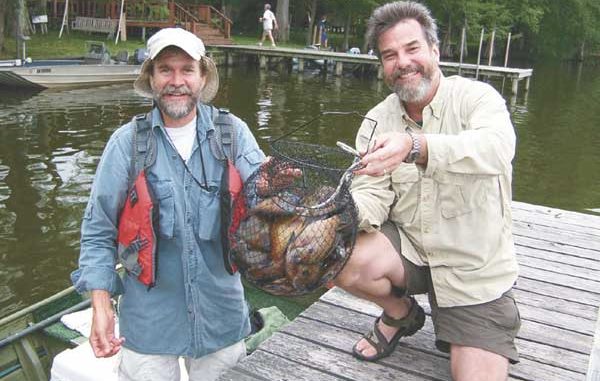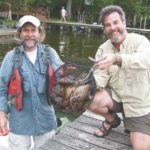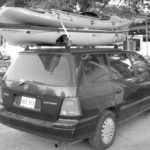
Lately I’ve been walking to a nearby lake rather than taking my vehicle. I often come home with mud on my sandals — at least my footprint contains no carbon. Al Gore would be pleased, even if my wife isn’t.
When it comes to leaving a carbon footprint, flyrodders are a mixed bag.
We are energy misers on the water. An overwhelming number of us either wade fish, fish from paddlecraft such as kayaks, canoes or pontoon boats, or fish from lightweight skiffs with motors under 50 horsepower.
Even as we go down the road, we conserve. Pulling a light skiff uses less gas than pulling a bay or bass boat. Toting a kayak or canoe hardly makes a dent. For example, my Toyota Highlander with a yak on top gets 24 miles per gallon on the highway, just a tad under its normal 27 m.p.g. Riding with the canoe is even better at 25 m.p.g.
My daughter gets 24 m.p.g. toting her Ocean Kayak on a Mercury Mariner. A friend of mine boasts the “green fishing machine” — a hybrid Toyota Prius and a Wilderness Systems yak.
Regardless of these milestones in fuel economy, don’t bet on Yours Truly and his pals getting nominated for “Environmentalists of the Year.” We guzzle gas with the best of them. Instead of doing one mile at a time, we do it many miles at a time.
Flyfishers are a traveling lot. There’s all those fly-fishing events: shows, conclaves, festivals. Roughly 150 nationwide annually. It’s not uncommon for a fly angler to attend several each year.
On top of that, we’re addicted to destination fishing. Those ads in the back of magazines promoting lodges in Alaska, Bahamas, Belize, South America and elsewhere attract flyrodders like moths to the flame.
Even many of us who aren’t lodge moths feel a need to go places. How about driving to Arkansas or Tennessee a few times each year for trout fishing, or to South Florida for snook or bonefish, or flying out to Montana?
We just don’t hit the road, we pound it unmercifully. At least we used to.
Not only has escalating gas prices slowed our traveling ways, but airfares are killing us. My two sons and I used to fly out to Utah each summer to fly fish for trout. We never paid more than $200 roundtrip per ticket. Even last summer, my flight to Salt Lake was under $300. This year the lowest fare is more than $400, and that doesn’t include the new fees for checked-in baggage.
Like everyone else, flyfishers are concerned not only about our cost of energy, but it’s impact on society. It’s not that we weren’t warned.
For years, Congressman Roscoe Bartlett has been delivering a presentation on the topic of “Peak Oil,” usually when the C-SPAN cameras are rolling. The Maryland Republican was a research scientist who worked on projects for NASA. He doesn’t just talk up the need for alternative energy, he lives it by driving a Toyota Prius and using solar panels on his home.
Bartlett and fellow Congressman Michael Burgess, R-TX, are leading the efforts to change U.S. energy policy by looking at solutions that make sense for the long term.
Peak oil is when the maximum rate of global petroleum extraction is reached, after which the rate of production enters terminal decline. But even before that point is reached, there’s the point at which cheap oil becomes scarce, and aggravated by increasing world demand, causes market forces to send oil prices escalating — as they are now.
A recent issue of The Economist magazine had a special article entitled “The Future of Energy” that echoes many of the thoughts that Bartlett and Burgess have put forward. Basically, our energy future needs to be as diverse as possible — solar, wind, geothermal, coal, nuclear, biofuels, hydroelectric. All have to be part of the mix.
Not only diverse, but sensible. For example, Washington has been heavily subsidizing corn-based ethanol, touting it as a gas replacement. And now we’re seeing the repercussions. Corn is critical for our world food products. It’s also a very poor feedstock for fuel with an energy output of only 1.7 units to 1 unit of energy in. Per acre, sugar cane and sugar beets have an ethanol yield of twice that of corn.
The long-term solution for biofuels will be celluosic ethanol, or better yet, celluosic butanol. Biobutanol is in its infancy stages, but great progress is being made. Several companies, including Dupont and ButylFuel, are prototyping production plants.
Butanol has superior properties to ethanol. It’s BTU content is 30-percent higher, roughly that of gasoline. It can be shipped through existing fuel pipelines, where ethanol cannot. Butanol can be used as a 100-percent replacement for gasoline, while ethanol can only be used in an 85-percent blend. Butanol can also be used in outboard motors, and it emits no greenhouse gases.
Biobutanol and biodiesel (for larger vehicles) will provide part of our transportation solutions. Most vehicles will be hybrids or plug-in electrics.
The newest battery technology — superlattice lithium-ion — can deliver an electric car capable of 200 miles or more on a single charge. Although these batteries will be very expensive at first, the volume of production will lower their costs in the same manner that it did for cell phones and DVD players.
Research is also under way to develop batteries that can fully charge in 10 minutes or less, and some experimentation has already reached that level. If you think about the average stay at the gas pump, going inside the Kwik-Mart to buy a soda and use the bathroom, we may already have solved the greatest obstacle to widespread use of full-electric vehicles.
And so my friends, I envision a day — hopefully soon — where I can fly on a biodiesel-powered jet to Salt Lake, or load my kayak on top my butanol-hybrid SUV, and know that my fuel was made in America, and my money is going to hard-working Americans, and not some dictator in Iran, Venezula or Nigeria.
Tying clinics
The North Louisiana Fly Fishers will conduct fly tying clinics at the Bass Pro Shop in Bossier City on Aug. 9 and 23. Times for both sessions are noon to 4 p.m. No registration is required.
Fly fishing basics
The Red Stick Fly Fishers will hold their annual “Fly Fishing 101” on Sept. 13 at the LDWF Waddill Outdoors Education Center in Baton Rouge. Time is 8:30 a.m. to 3 p.m. Sessions include fly casting, fly tying, knots and leaders and presentation. The event is open to the public, and lunch and refreshments are provided. There is no cost; however, registration is required as attendance is limited to 40 persons.
For details, check www.rsff.org, contact Dan Weber at (225) 767-2405 or email dweber@aol.com.
Cichlids update
My June column got the word out. Recently, I’ve run across several flyrodders chasing the Rio Grande cichlids at City Park in New Orleans. The action has picked up with the hot weather, with most of the catches coming on black woolybuggers, jitterbees and black foam spiders.




